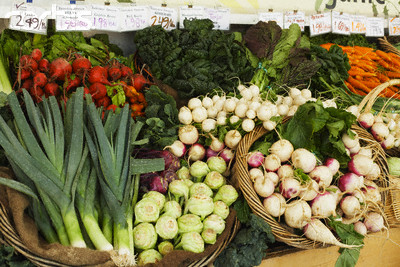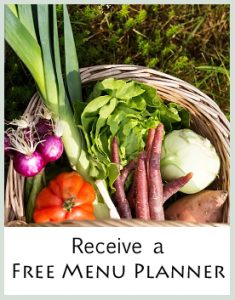
I receive a lot of emails from people who have found my site and are looking for ideas for their very limited diet. Some of these people are at a complete loss as to what to eat because their diet is so limited. I received one of these emails from someone last week inquiring about a diet for her daughter.
Here was her list of foods that her daughter was told to avoid:
gluten (wheat, barley, oats, spelt, kamut, tricale, and all products containing gluten such as soy sauce, etc)
grain (includes rice, millet, teff, and other gluten-free grains)
dairy
egg
soy
corn
banana
kiwi
This is a similar list to many of the people who come to me. There are definite variations and more limited diets like those without any meat or fish, legumes, nuts, all fruit, etc. But I thought I’d start with this diet to give you some ideas on where to start.
So what do you do when you get a list like this? My hope is that in this post, I can give you my process for starting to come up with some foods and recipes you can eat when you receive a long list of foods you should be avoiding, even temporarily.
I am also working on compiling my recipes into menu plans for different diets such as this one so that people can have a menu planner for their specific limited diet. I am also going to start writing some blogs about how you can start to do this for yourself!
1. Focus on what you can eat, not what you can’t! Make a long list of all the foods available in your grocery store, farmer’s market and local health foods store. Make categories for the main food groups and list all the foods under them that you can find.
Categories would include: meat, seafood, dairy products, fruits, vegetables, herbs, spices, glutenous grains, gluten-free grains, grain-free “grains,” condiments, nuts, seeds, legumes, and sweeteners.
The most difficult part of receiving a list such as the one from this woman for her daughter, is that you have to be very creative when it comes to having foods that resemble grains, baked goods and pastas.
As a little help in the grain and grain-free department, here is a list that you can start with. There may be others on the list I haven’t thought of or forgot to include:
Wheat-free grains:
spelt, oats, kamut, rye, barley plus all gluten-free and grain-free “grains”
Gluten-free grains and flours:
rice, all varieties
brown rice
corn
gluten-free oats
teff
millet
sorghum
Grain-free “grains,” flours and seeds
buckwheat
pecan meal and other nut meals (made from grinding any nut very finely)
hemp seeds (great as protein powder)
tapioca – this is made from the cassava root
sunflower seeds (can be ground)
sesame seeds (can be ground up as well)
As you can see the grain-free list is pretty long! I could probably keep going but I’ll stop there. It’s really just a matter of knowing what to do with these ingredients once you figure out that there is quite a bit of variety out there!
2. Highlight all the foods you can eat on the list. Focus on these foods and what you can create from them. This first step will help you immensely if you can get through it.
3. Going back to the example diet that I listed before, here are the things that her daughter can eat based on doing this process.
All meat and seafood – this is a huge plus if you’re in this boat. The challenge with this is some kids just don’t like meat or won’t eat it. But if you aren’t a vegetarian but have a limited diet, this helps a lot with meal planning. Also, you can bread fish and chicken with almond or pecan meal and it makes it more appealing to children.
You can also make chicken puree and slip this into things like potato pancakes. More on this in a future post.
All veggies and all fruit except for corn, banana and kiwi. It’s also helpful that her daughter can still eat potato as this is in a lot of foods and can also be used as a starch in baking. Vegetables and fruits are so versatile – a great opportunity for creativity.
All beans except for soy. Beans are hard to digest in general so this may be something that she would eat every now and then but it also depends on her health issues. Chickpeas can be ground into a flour as well as others such as fava beans. I personally don’t like the taste and find them hard to digest as flours but they are an option.
All nuts and seeds. This is extremely helpful that she can still eat nuts and seeds. Peanut butter isn’t even on her list (though this is a legume). Nuts can be used as nut butters, flours, nut milk ( which would be a good option for her for a milk alternative since she can’t have soy or rice), cheese (though commercial brands have casien in them), as breading on chicken or fish, dairy-free cheese sauces (cashews) or just eaten whole as a great snack. They are most digestible however if they are soaked and then dehydrated.
Most condiments: mustard, ketchup, vinegars, lemons and limes, oils. As far as mayo goes, you can find an egg-free version but it’s made with soy. I have a recipe for mayo made from cashews but I haven’t tried it yet.
All herbs, spices, chocolate and carob: You can make a meal with a piece of fish or chicken, some garlic and onions, vegetables and some fresh herbs and spices. Very simple but very good. There are infinite ideas and recipes out there in terms of just using meat or fish, vegetables and fresh herbs and spices.
She can also still eat chocolate and carob as long as it’s dairy-free and grain-free. You could make grain-free chocolate or carob muffins, cookies, cakes, etc (search for grain-free and egg-free dessert recipes). Even make your own hot chocolate with some cocoa powder, nut milk and a sweetener.
All sweeteners: also another plus. Try to stick to raw honey, agave, molasses and real maple syrup.
Some alternatives for what she can’t eat:
Eggs: This can be a tough one if you’re used to baking with eggs or having them for breakfast. However, there are several egg substitutes you can use when you’re baking, as long as you’re not making a quiche. There are egg-free quiches but they are made with tofu, and she can’t have soy, so that is out.
As far as some other breakfast items, this is going to be more challenging without the eggs, grains and dairy-products. But here are some ideas:
turkey or chicken sausages
grain-free pancakes
amaranth bread
turkey bacon
quinoa or buckwheat muffins, made grain-free, egg-free and dairy-free
nut butter on grain-free crackers
fresh fruit – smoothies, fruit salad
Dairy-free alternatives: This is really a topic in and of itself, so I won’t go into this completely. But as I mentioned earlier, her choice milk would be almond or another nut milk or hemp milk. You can make your own nut milk very easily. Coconut milk would also be a good option.
As far as cheese goes, here is a good dairy-free cheese that is also grain-free.
Some people can eat ghee in place of butter, which is clarified butter. Also, coconut butter is a great alternative to butter. It is delicious!
She can also eat coconut yogurt and coconut ice cream, great alternatives (and yummy too) since she can’t have dairy, soy or rice.
Cornstarch alternative: Arrowroot powder can be used part for part in baking recipes that call for cornstarch. You will also need to find a corn-free baking powder for baking.
Soy-free soy sauce: One last tidbit I’ll leave you with. Here is a recipe I recently came across for soy-free soy sauce. It looks very good to me but I haven’t tried it yet. A good alternative for someone who loves asian food but can’t have soy.
4. Get organized: Once you have compiled a list of recipes you’d like to try that fit your new diet, the next step is to organize them for them week. Print them out or make copies from cookbooks. Then look through the ingredients to see what you need to add to your shopping list for the week. Then, yes, go shopping, or order unusual ingredients online.
5. Be brave and take baby steps: Take the last step and be brave to try something new. It can seem daunting at first to use unusual ingredients you’re not used to using in cooking and baking. But start with something most familiar to you and go from there. Take baby steps. Try one or two new ingredients a week so you don’t get overwhelmed by too many choices.
6. Don’t get too discouraged: Expect to have some flops. You’re learning something new and it may take some time to learn some new tricks of the trade. But be patient and keep trying. Pretend you’re on an adventure and your next meal is your next mission. This may sound corny but if you can get excited about creating new and delicious foods, you will most likely have better results than if you think you’re making another disaster.
Good luck! I’d love to hear from you so leave a comment about your own adventures in allergen-free cooking and baking!
All the best,
Sarah

Sarah, this is such an encouraging post! Kudos for showing that a restricted diet can be a rich, nourishing, and varied diet. Necessity is the mother of invention, right? Cheers to grain-free breads and batters, coconut milk yogurts, date-sweetened desserts, and roasted red pepper pizza sauces!
What a great resource this is. I am a nutritionist and teach cooking classes that abide by all of these. I have actually been eating this way for over five years now, since being diagnosed with Crohn’s (and symptom free for 3+ years). Focussing on what you can eat is key, as is having an open mind, a sense of creativity and experimentation and finding a community that eats like you.
Thanks for the great information! Before reading this I didn’t know how people handled such diet restrictions without getting bored. Really appreciated this article!